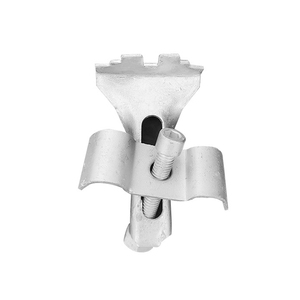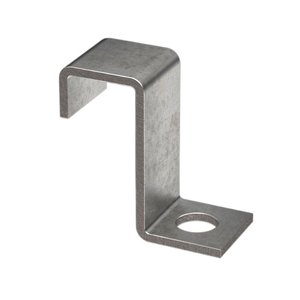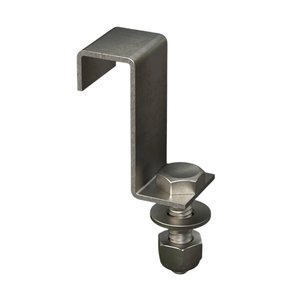
All categories
Featured selections
Trade Assurance
Buyer Central
Help Center
Get the app
Become a supplier

(750 products available)





















































A steel grating installation clip is a device used to secure metal grids to supporting beams or structures. They provide a safe and stable installation for walkways and platforms. Steel grating clips come in different types, which vary in design, function, and application. Here are some of them:
Locking Clips
These clips have a two-part design consisting of a male and female component. The male part has a small locking mechanism, while the female part has a corresponding socket. The male and female parts are inserted and twisted to lock them securely. They are widely used in applications where easy installation and removal are needed. They are also used when high strength and stability are required. These include drainage covers, steel grating covers, and industrial steel grating.
Bolted Clips
This type of clip has a simple design with a bolt and nut assembly. The steel grating has a hole that aligns with the support beam. A bolt is inserted into the hole and secured with a nut to form a strong connection. The installation process requires tools like spanners to complete the process. These clips provide high strength and stability and are suitable for permanent installations. They are also used in applications that require easy maintenance and inspection. Examples of applications where these clips are used include oil and gas, petrochemical, and wastewater treatment plants.
Welded Clips
These clips have a robust design consisting of a steel plate with a hook and a long bolt. The installation process involves welding the steel plate to the support beam and inserting the hook into the grating. A nut is used to secure it, and the other end is welded to the support beam. They are permanently installed and provide high strength and stability. They are also used in applications that experience high vibrations and movements. They are commonly used in heavy industries like mining, power plants, and steel manufacturing.
Spring Steel Clips
These clips have a simple design consisting of a spring steel strip bent into a U shape. The installation process involves inserting the clip into the support beam and placing the grating on top. The tension created by the spring action holds the grating and support beam firmly in place. These clips are easy and quick to install. They are also reusable and provide good drainage. Applications where these clips are used include pedestrian walkways, temporary platforms, and light-duty industrial applications.
Steel grating installation clips have different applications in construction projects. Their features enhance the functionality of steel gratings. Here are their key features:
Material Quality
Steel grating clips are made from high-quality steel. Usually, it's the same steel used for the grating. It can also be made from other materials like stainless steel, aluminum, or galvanized steel. This ensures that the clips have the same longevity as the grating.
Corrosion Resistance
The steel grating installation clips are either coated or treated to enhance their corrosion resistance. This feature is important in environments prone to harsh weather elements and chemicals. The coating or treatment process includes: Epoxy coating, Hot-dip galvanizing, Powder coating, Electrophoretic coating.
Robust Construction
The steel grating clips are manufactured using advanced technologies like CNC machines, welding robots, and bending machines. This enhances their precision, stability, and strength.
Easy Installation
The clips are designed to ensure that the installation of the steel grating is quick and safe. This reduces the need for complicated tools and additional hardware. For example, a slip-on clip provides safe and quick installation for all types of steel grating.
Slip-On Design
Some steel grating installation clips have a slip-on design, which allows for quick and easy installation. The design feature eliminates the need for welding or bolting the entire length of the grating. These clips are ideal for temporary installations and applications where quick access and removal are required.
Multiple Configurations
Steel grating installation clips have various configurations, such as through clip, hook clip, and L-shaped grating clip. Each configuration provides different load-bearing capacities and installation requirements.
Load-Bearing Capacity
The steel grating installation clips are designed to bear heavy loads. Their design features, such as welded joints, mechanical fasteners, and bolted connections, ensure that they distribute weight evenly and provide strong connections.
Power Plants:
Steel grating installation clips are crucial in power plants, securing steel gratings on walkways, platforms, and stairways. These installations allow maintenance crews to access essential machinery and components safely. The clips provide stability and strength for the heavy traffic in these high-demand environments.
Industrial Facilities:
In industrial facilities like oil and gas refineries, chemical plants, and manufacturing plants, the installation clips secure steel gratings on walkways, catwalks, and platforms. They are beneficial in areas with high foot traffic, heavy machinery, and harsh environmental conditions. The clips enhance the durability and stability of the steel grating, ensuring a safe working environment for personnel.
Commercial Buildings:
Steel grating installation clips are also commonly used in commercial buildings. The clips secure steel grating for exterior walkways, parking garages, and interior applications like stair treads and floor panels. The installation clips enhance the stability and strength of the steel grating while providing a long-lasting and low-maintenance flooring solution.
Bridges and Overpasses:
The installation clips are essential in bridge construction, particularly in securing steel grating for pedestrian walkways and ventilation. The installation clips enhance the stability and strength of the steel grating, ensuring the safety of pedestrians and vehicles.
Marine Applications:
Steel grating installation clips are also commonly used in marine applications, including ships, boats, and offshore oil rigs. The clips secure steel grating for walkways, decks, and platforms, ensuring the stability and strength of the steel grating in harsh marine environments. The installation clips are resistant to corrosion and extreme weather conditions, providing a long-lasting and low-maintenance flooring solution.
When buying installation clips for steel grating, several factors must be considered to ensure they meet specific requirements. Here are some key points to take into account before making any purchases:
Load-bearing capacity
Think about the load the grating will support. Heavy loads, such as pedestrian foot traffic or machinery, require strong clips. Stronger clips are adequate for lighter loads, like industrial walkways or platforms.
Environmental conditions
The type of material used to make the clip determines its performance in different environments. Stainless steel works best in humid or corrosive settings. For dry, industrial situations, carbon steel or galvanized steel is suitable.
Compatibility
Ensure that the clip is compatible with the type and thickness of the grating being installed. Check factors like bar size, spacing, and material. Purchase clips that work well with the specific grating to be used.
Ease of installation
Look for clips that allow for quick and simple installation. Features like adjustable clips, minimal welding or cutting, and user-friendly designs can save time and effort during installation.
Safety standards
Ensure that the selected grating clips meet local building codes and safety regulations. This guarantees compliance and ensures the safety of the installed grating, mainly when used in industrial or public spaces.
Long-term expenses
While the initial price of the grating clip is essential, consider its long-term cost. This includes possible maintenance, replacement expenses, and lifespan. A more expensive clip upfront may prove more cost-effective if it lasts longer and requires less maintenance.
Adjustability
In some installations, particularly in industrial and commercial settings, the load conditions or configurations may change over time. Therefore, it is advisable to choose adjustable grating clips. These clips can adapt to various conditions and loads, providing continued support and stability.
Aesthetics
In applications where the grating is visible, such as architectural features or decorative walkways, consider the aesthetics of the clip. Choose clips with a sleek profile or finish that blends seamlessly with the overall design.
Q1: What are the common types of steel grating installation clips used in industrial settings?
A1: There are four common types of clips. The C-shaped steel grating clip is a universal grating clip with a C shape that fits most bar sizes. It has a male and female part that interlocks to secure the grating. The G-shaped steel grating clip has a G shape and provides maximum grip and support for heavy-duty grates. The flat steel grating clip is ideal for flat bars and offers a low-profile and aesthetic look. It is suitable for pedestrian walkways and areas where comfort and safety are paramount.
Q2: What factors should be considered when choosing a steel grating clip?
A2: The important factors to consider are load-bearing capacity, environmental conditions, and grating material. Others are installation requirements and maintenance.
Q3: What are the installation requirements for steel grating clips?
A3: The installation requirements include the right tools, proper alignment and positioning, and load-bearing bars. Others are safety precautions and manufacturer guidelines.